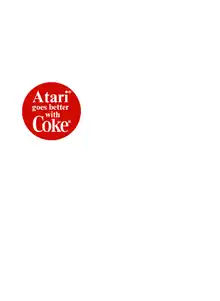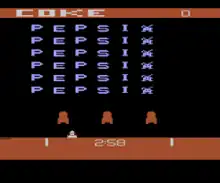| Pepsi Invaders | |
|---|---|
 | |
| Developer(s) | Atari, Inc. |
| Publisher(s) | The Coca-Cola Company |
| Programmer(s) | Christopher Omarzu[1] |
| Platform(s) | Atari 2600 |
| Release | 1983 |
| Genre(s) | Fixed shooter |
| Mode(s) | Single-player |
Pepsi Invaders (erroneously identified as Coke Wins and Coke Invaders) is a non-commercially released 1983 fixed shooter video game developed by Atari, Inc. for the Atari 2600. It was commissioned by The Coca-Cola Company to be handed out to salespeople at their 1983 sales convention. A reskin of the system's version of Space Invaders, the player shoots down a flying formation of letters spelling "PEPSI", Coca-Cola's long-time rival. Only 125 copies were distributed.
Gameplay

The game is a modification of Space Invaders, with nearly identical gameplay, but with a number of tweaks. Instead of having limited lives and no time limit as in the original, Pepsi Invaders has unlimited lives and a three-minute time limit to complete as many waves of enemies as possible. If any invaders successfully traverse the lowest row, instead of the formation dropping to the ground and ending the game, it merely moves left and right until all the lowest row invaders are destroyed. It is therefore impossible to lose the game.
Primary graphic changes affected the invaders, each row of which consists of the letters "P E P S I" followed by a single alien, instead of the original six aliens per row.[2] The letters move up and down as they march but do not otherwise animate. The UFO was changed to look like a flattened Pepsi logo in brand colors. A timer was added, displayed on the ground, which itself has been changed to a Coca-Cola-like brown color.[3] An additional band of the same color frames the score at the top, with the word "COKE" prominently displayed to the left of the score. The player cannon now features two bands of the same brown color.
During the last 10 seconds, the timer and cannon limit indicators blink. When the time runs out, all invaders and UFOs disappear, the score changes to the word "WINS" (thus making the row read "COKE WINS!"), and the player cannon and all texts flash rapidly. The player's final score can be seen in the attract mode after the game ends.
Development
Pepsi Invaders was commissioned by The Coca-Cola Company to be handed out to 125 executives at their 1983 sales convention along with an Atari 2600 console. It was developed by Atari, Inc. as a modification of the original Space Invaders cartridge.[1][3] Due to the original Space Invaders Atari 2600 developer Rick Maurer leaving Atari over payment issues, Atari tasked designer Christopher Omarzu with hacking the original.[4][1]
The game was delivered as a black cartridge with no label,[5] in a plain white box with an "Atari goes better with Coke" sticker on the cover.[6] The intent was to boost the morale of Coca-Cola's employees,[7] but most of the cartridges were discarded by their recipients.[8] Pepsi Invaders has been mistakenly labelled Coke Wins and Coke Invaders, to the confusion of Omarzu.[4][9][1]
Legacy
Writer Matthew S. Eastin notes it as an early example of an advergame–an advertisement game–and discussed how it was more an attack on a competitor than an advertisement by the company who had it made.[10] The Guardian included it in its list of the best product placement video games, similarly noting it as an early example of this and a "mischievous" marketing attempt.[11] PC Format felt the marketing was smart, comparing it to The Apprentice.[12] Retro Gamer was critical of Pepsi Invaders due to the letters not moving downward as the ships do in Space Invaders.[13]
Copies of the game have sold for up to US$1,825 on eBay.[8][14]
See also
References
- 1 2 3 4 "Coke Wins: The True Story!". Digital Press. No. 46. p. 4.
- ↑ Carless, Simon (2007-05-13). "The Rarest Atari 2600 Games... Evah!". GameSetWatch. Archived from the original on January 13, 2019. Retrieved 2010-06-23.
- 1 2 Ian Bogost (2007). Persuasive Games: The Expressive Power of Videogames. MIT Press. pp. 276–277, 391. ISBN 978-0-262-02614-7.
- 1 2 "Attack of the Space Mutants". Retro Gamer. No. 41. p. 26.
- ↑ "Early Advergames, part IV". Kotaku. 2007-11-16. Archived from the original on October 14, 2012. Retrieved 2010-06-23.
- ↑ Is This One of The Rarest Video Games?. CGC Video Games. October 4, 2023. Retrieved October 14, 2023.
The cartridge does not have a label like most Atari games, and the box is mostly blank, except for the Atari goes better with Coke sticker.
- ↑ Lindsay Grace (2019). Doing Things with Games: Social Impact Through Play. CRC Press. p. 127. ISBN 978-0429771316. Retrieved August 22, 2019.
- 1 2 Reiner, Andrew (September 27, 2009). "A Fortune In Pixels!". Game Informer. Archived from the original on August 17, 2019. Retrieved August 22, 2019.
- ↑ Atwood, Brett (March 30, 1996). "PC Users Gobble Up Pac-Man, Classic Games". Billboard. p. 124.
- ↑ Eastin, Matthew S. (2010). Handbook of Research on Digital Media and Advertising: User Generated Content Consumption: User Generated Content Consumption. IGI Global. p. 438. ISBN 978-1605667935. Retrieved August 22, 2019.
- ↑ Freeman, Will (July 13, 2014). "Six of the best product placements in video games". The Guardian. Archived from the original on August 17, 2019. Retrieved August 22, 2019.
- ↑ Gera, Emily (August 22, 2010). "The many faces of in-game advertising". TechRadar. Archived from the original on August 17, 2019. Retrieved August 22, 2019.
- ↑ Maris, Peter (January 20, 2011). "Pepsi Invaders". Retro Gamer. Archived from the original on August 3, 2015. Retrieved August 22, 2019.
- ↑ Quilty, Conrad (2005-10-18). "Atari game sells for $2,000 on eBay". Joystiq. Archived from the original on October 14, 2012. Retrieved 2010-06-23.